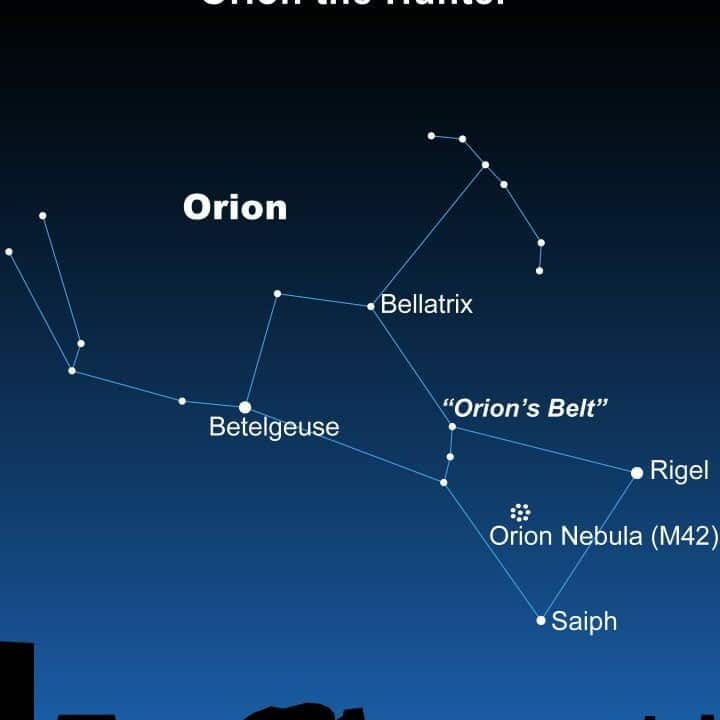Betelgeuse, also known as Alpha Orion, can be found in the constellation of Orion. It is the second brightest star in Orion and the ninth brightest star in the entire sky. This red supergiant is located approximately 643 light years away. Betelgeuse is currently in the final stages of its life and is expected to explode as a supernova in the near future.
If you are looking for Betelgeuse, you can easily find it in the winter sky. It is a large, bright, and massive star that can be found in the shoulder of the Orion constellation, opposite Bellatrix. To locate the exact position of Betelgeuse, you can use our online star map.
Betelgeuse, an astronomical object known as a variable star, has the ability to occasionally surpass the brightness of Rigel, another star. The term “Betelgeuse” originated from the Arabic translation of “the hand of Orion.” In modern Arabic, the word “al-Jabbar” translates to “giant.” However, during the translation process, the letter Y was mistakenly replaced by the letter B, resulting in the name “Betelgeuse” being an unintended error. In the following sections, you will gain knowledge regarding various aspects of Betelgeuse, including its distance from Earth, latitude, coordinates, classification, declination, color, and luminosity level. Accompanying the descriptions, you will find a collection of photographs and diagrams to enhance your understanding.
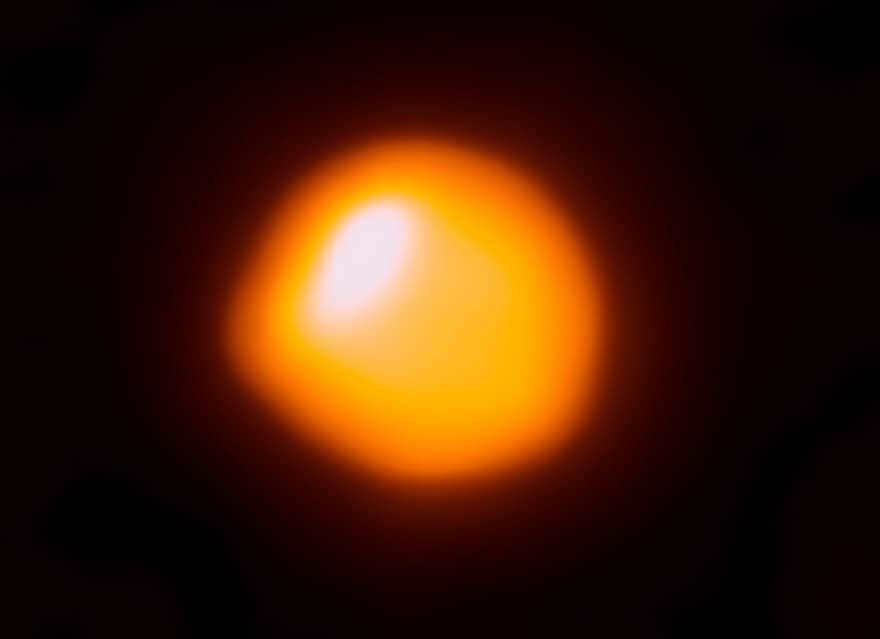
The star known as Betelgeuse can be found in the upper left shoulder of the constellation Orion. If it were placed in our solar system, it would extend beyond the asteroid belt and come into contact with the orbital path of Jupiter.
Betelgeuse falls into the spectral class M2Iab, with “lab” indicating that it is an intermediate luminosity supergiant. Its absolute magnitude measures -6.02. The mass of Betelgeuse ranges from 7.7 to 20 times that of the Sun. It is approximately 10 million years old and has an average luminosity that is 120,000 times greater than that of the Sun.
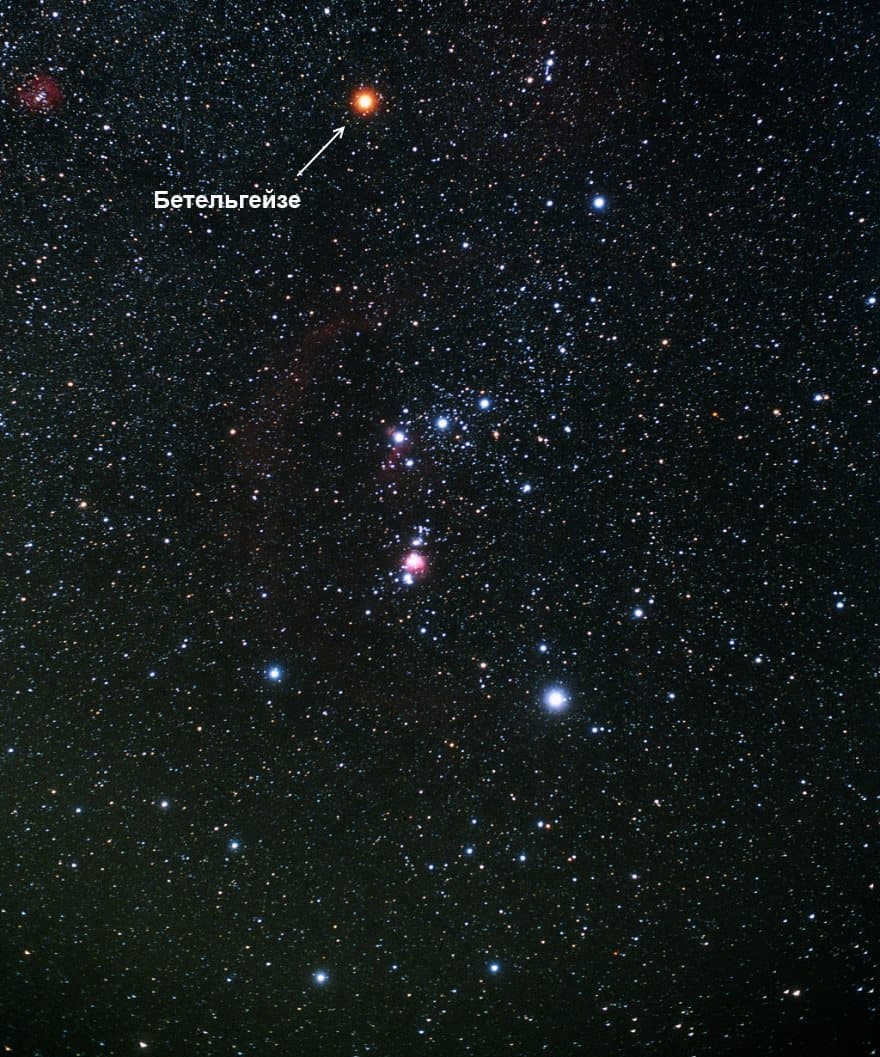
Position of Betelgeuse in the Orion constellation
The apparent brightness ranges from 0.2-1.2 over a period of 400 days. As a result, it occasionally surpasses Procyon and becomes the 7th most luminous star. During its peak brightness, it outshines Rigel, while during its dim phase, it falls below Deneb and becomes the 20th brightest.
The absolute brightness of Betelgeuse fluctuates between -5.27 and -6.27. The outer layers of the star expand and contract, causing the temperature to rise and fall. Pulsations occur due to an unstable atmospheric layer. It absorbs more energy when it is in an absorbed state.


The compilation presents the Orion constellation (with an arrow pointing to the Betelgeuse star), the trajectory leading to Betelgeuse, and the ESO telescope’s most accurate capture of this supergiant.
There are multiple pulsation cycles, including short-term variations lasting from 150 to 300 days, as well as long-term ones spanning over 5.7 years. Due to its rapid mass loss, Betelgeuse is enveloped by a massive shell of material, rendering it challenging to observe.
Back in 1985, a pair of satellites were observed circling around the star, but their existence was not officially verified during that period. Betelgeuse is a relatively easy celestial object to locate due to its position within the Orion constellation. It can be seen from any point on Earth, except for those located at 82°S latitude, between the months of September and March. For individuals residing in the northern hemisphere, this star emerges in the eastern sky shortly after sunset in the month of January. During the summer season, however, Betelgeuse remains concealed behind the Sun, rendering it invisible to the naked eye.
Supernova
Betelgeuse is approaching the end of its evolutionary development and is expected to undergo a Type II supernova explosion within the next million years. This event will be incredibly bright, with a visual magnitude of -12, and will be visible for a period of a few weeks. Unlike the previous supernova, SN 1987A, which could be seen without the aid of instruments, Betelgeuse’s explosion will occur in the Large Magellanic Cloud, which is located 168,000 light years away. While this celestial event will not pose any danger to our system, it will undoubtedly provide an unforgettable spectacle.
Despite its relatively young age, Betelgeuse has already depleted a significant portion of its fuel supply. As a result, the star is currently undergoing a process of contraction and increased internal heat. This has caused helium to transform into carbon and oxygen through a process known as fusion. Eventually, the star will experience a catastrophic explosion, leaving behind a neutron star with a diameter of approximately 20 kilometers.
The mass of a star always determines its finality. The exact number remains uncertain, but many speculate that it is ten times larger than the Sun.
Interesting Information
Let’s explore some fascinating facts about the star Betelgeuse, complete with photographs and views of its neighboring stars in the Orion constellation. For more in-depth information, utilize our 3D models, which allow you to navigate through the galaxy’s stars at your leisure.
It is a component of two winter asterisms and holds the upper position in the Winter Triangle.
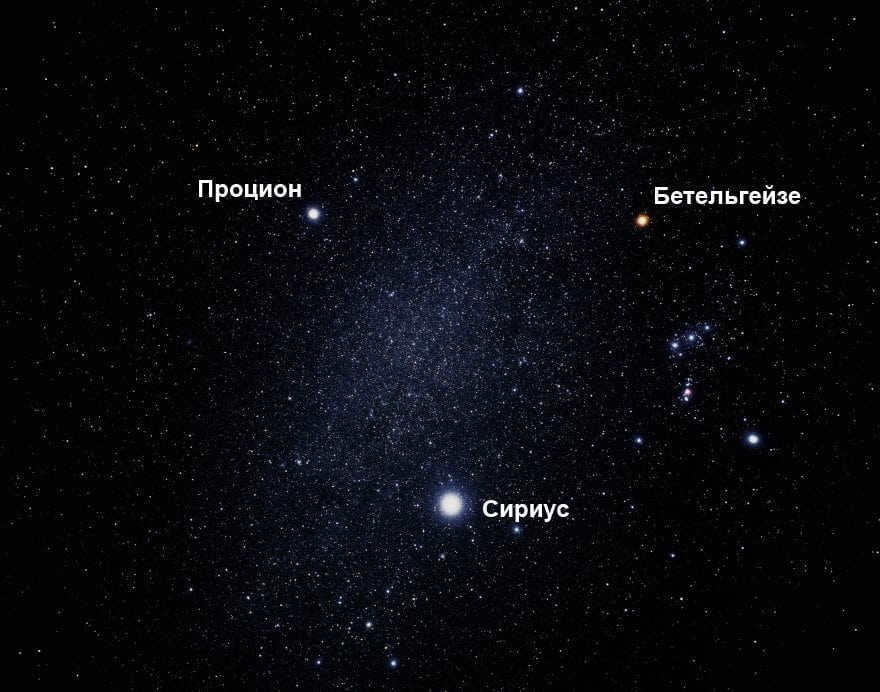
Stars found within the Winter Triangle
Procyon and Sirius occupy the remaining corners. Betelgeuse is also included in the Winter Hexagon, alongside Sirius, Procyon, Pollux, Capella, Aldebaran, and Rigel.
Back in 2013, it was predicted that Betelgeuse would collide with a “cosmic wall” made of interstellar dust in approximately 12,500 years.
Betelgeuse is a member of the Orion OB1 Association, a group of stars that share the same motion and speed in space. This red supergiant is thought to have deviated from its original path because it does not intersect with areas where stars are formed. It may have originated as a runaway member around 10-12 million years ago within Orion’s molecular cloud.
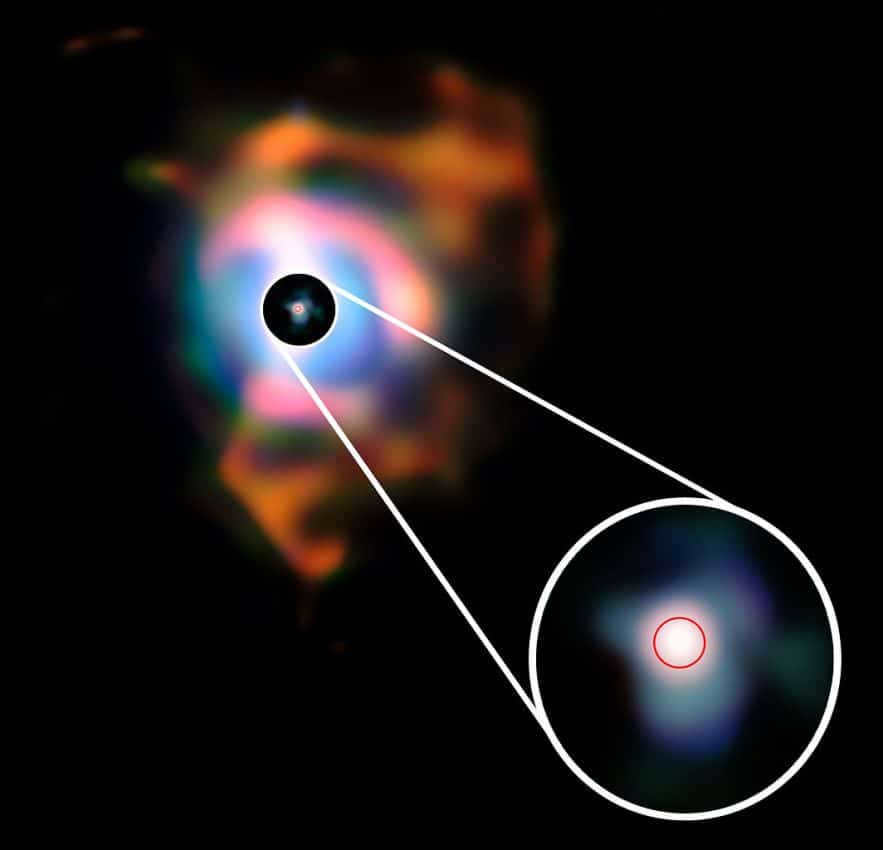
The star is currently in motion with an acceleration of 30 km/s, causing the formation of a shock wave spanning 4 light-years. The star’s wind is expelling vast amounts of gas at a velocity of 17 kilometers per second. This phenomenon was first observed in 1997, and the formation itself is estimated to be around 30,000 years old.
Alpha Orion is the most luminous source in the nearby infrared region of the sky. Only 13% of its energy is detectable in visible light. In 1836, John Herschel documented the star’s variability. It outshone Rigel in both 1837 and 1839. This led Johann Bayer to mistakenly designate Betelgeuse as “alpha” (the brightest) in 1603.
According to scientists, Betelgeuse emerged around 10 million years ago as a blazing blue O-type star. It was originally estimated to have a mass 18 to 19 times that of our Sun. Interestingly, in the 20th century, the star’s name was documented as both “Betelgeuse” and “Betelgeuse”.
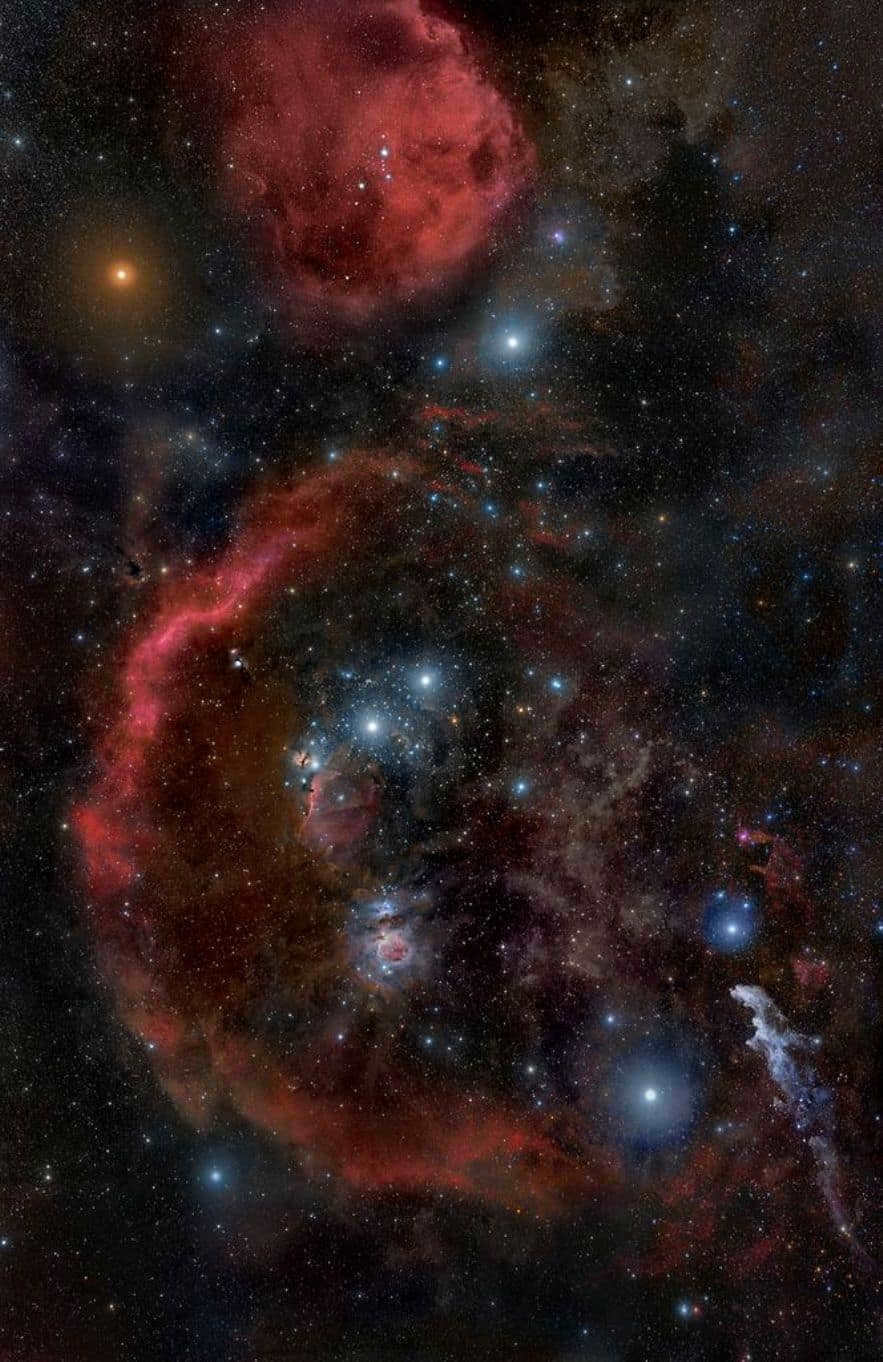

A picture taken in 2010 captures the nebular complex of Orion’s Molecular Cloud. It also reveals the red supergiant Betelgeuse (positioned at the top left) and Orion’s belt, which encompasses Alnitak, Alnilam, and Mintaka. Rigel is situated below, and the shape of a red crescent moon is formed by Bernard’s loop.
Betelgeuse has been documented with different names in various cultures. In the Sanskrit language, it is referred to as “bahu” because the Hindus observed a deer or antelope in the constellation. In China, it is known as Shenxia, which translates to “the fourth star,” in reference to Orion’s belt. In Japan, it is called Haike-boshi, as a tribute to the Haike clan, who adopted the star as a symbol of their clan.
In Brazil, the star was commonly referred to as Gilcavai, inspired by the heroic figure whose leg was torn off by his wife. In northern Australia, it earned the nickname Owl Eyes, while in southern Africa, it was associated with the lion that hunts the three zebras.
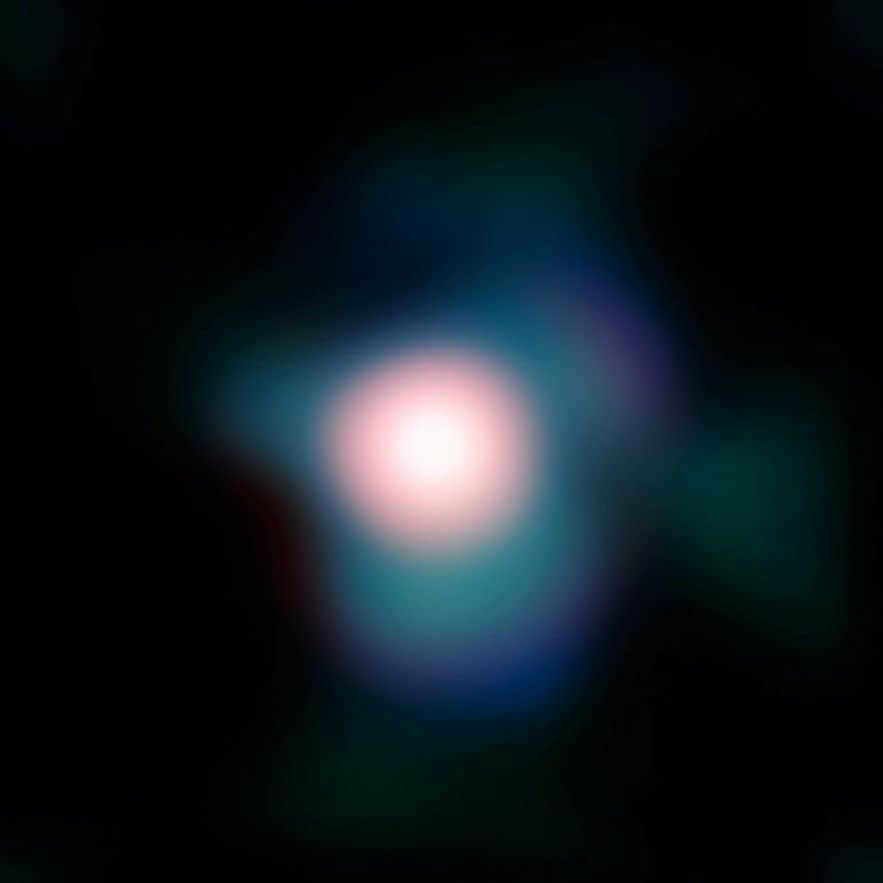
Betelgeuse is also featured in multiple movies and books. For example, the main character in the film “Beetlejuice” shares the same name as the star. In The Hitchhiker’s Guide to the Galaxy, Betelgeuse is the home system of Zaford Beeblebrox. Furthermore, Kurt Vonnegut includes a star named Betelgeuse in his novel The Sirens of Titan, and Pierre Boulle references the star in Planet of the Apes.
Dimensions
Determining the exact measurements is a challenging task, however, the estimated diameter of the star spans approximately 550-920 times that of the Sun. This celestial body is of such immense proportions that it appears as a discernible disk when observed through a telescope.
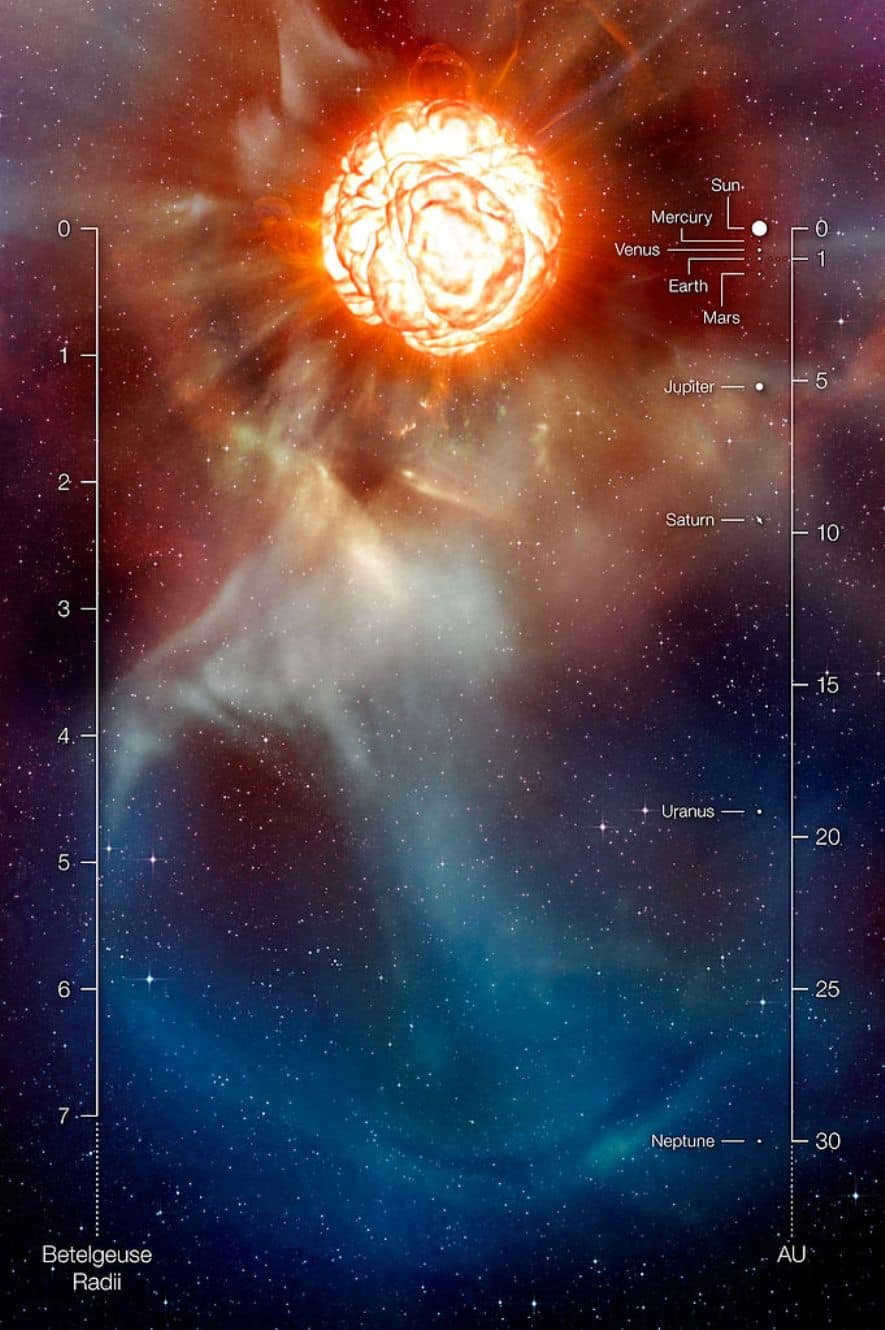
The infrared spatial interferometer was used to measure the radius, revealing a measurement of 3.6 a.u. In 2009, Charles Townes announced a 15% decrease in size since 1993, while retaining its brightness. This is likely due to the activity of the shell in the expanded atmospheric layer. Researchers have discovered at least 6 shells surrounding the star. In 2009, a gas emission was detected at a distance of 30 AU.
Alpha Orionis became the second star, after the Sun, where the angular size of the photosphere could be calculated. This achievement was accomplished by A. Michelson and F. Peiz in 1920. However, the results were imprecise due to attenuation and measurement errors.
Calculating the diameter is a challenging task due to the nature of the pulsating variable we are dealing with. This means that the figure will constantly fluctuate. Moreover, determining the stellar edge and photosphere proves to be difficult as the object is encompassed by a shell of ejected material.
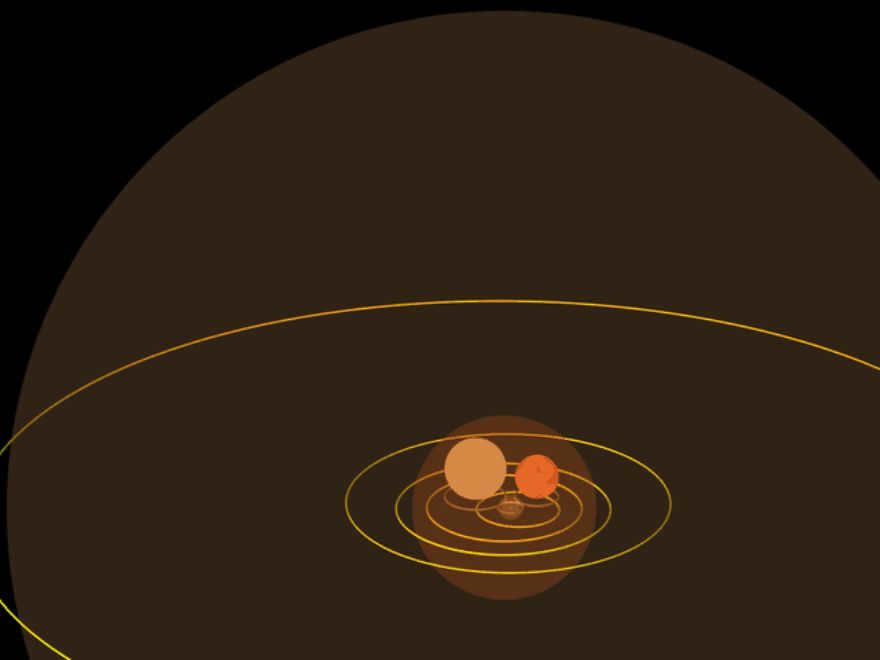

A comparison is made between the size of Betelgeuse, a large dim red sphere in the orbital path of Jupiter, and R Goldfish, a red ball inside Earth’s orbit. Additionally, the orbits of Mars, Venus, Mercury, and the stars Rigel and Aldebaran are highlighted. There is a faint yellow sphere with a radius of 1 light minute, and the yellow ellipses represent planetary orbits.
Betelgeuse was previously believed to possess the largest angular diameter. However, a recent calculation conducted by R of Goldfish has revealed that Betelgeuse now holds the third position in terms of angular diameter. In terms of radius, it can extend up to 5.5 a.u., but it also has the ability to shrink to 4.5 a.u.
Distance
Betelgeuse is located 643 light-years away in the Orion constellation. In 1997, it was estimated to be 430 light-years away, and in 2007, the estimate was revised to 520 light-years. However, the exact distance still remains a mystery. A direct parallax measurement indicates a distance of 495 light years, but when natural radio emission is taken into account, the distance is calculated to be 640 light years. Data obtained in 2008 by the VLA suggests a distance of 643 light-years.
The color index of Betelgeuse is (B-V) 1.85. This means that Betelgeuse is a red star.
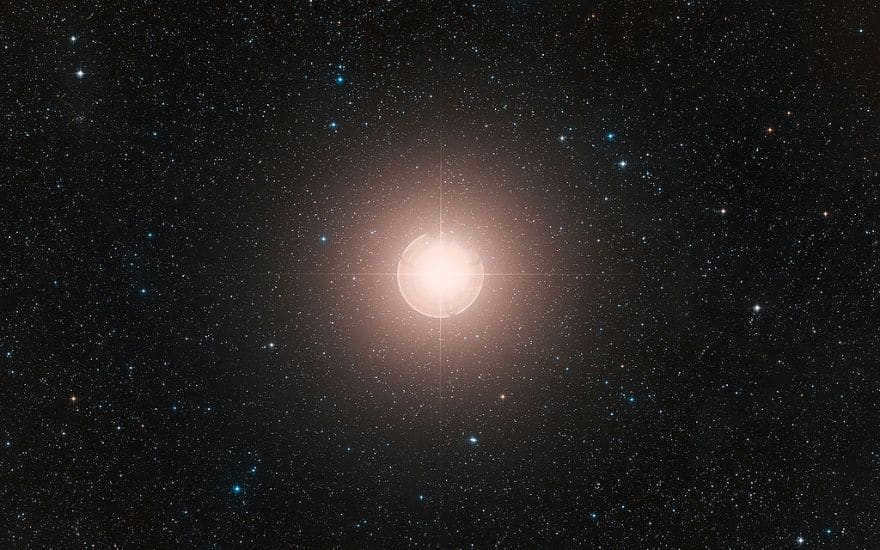

This image showcases the color composition of Betelgeuse as captured by Digitized Sky Survey 2. It provides a fascinating view of the star’s extended atmosphere, resulting in the presence of blue emission lines rather than absorption. Interestingly, even ancient stargazers were aware of Betelgeuse’s red hue. In fact, Ptolemy, a renowned astronomer from the 2nd century, provided a detailed description of the star’s color. Moreover, Chinese astronomers, three centuries prior to Ptolemy, observed Betelgeuse’s yellow color. This disparity in color descriptions can be attributed to the possibility that Betelgeuse was a yellow supergiant in earlier times.
Betelgeuse’s photosphere reaches temperatures between 3140-4641 K, while its atmosphere is slightly cooler at 3450 K. As the gas expands, it cools down accordingly.
Physical characteristics and orbit
- Betelgeuse serves as the Alpha star in the Orion constellation.
- It is located at the following coordinates: 05h 55m 10.3053s (right ascension), + 07° 24' 25.426" (declination).
- Belonging to the spectral class M2Iab, Betelgeuse exhibits a magnitude of 0.42 in the visible spectrum (ranging from 0.3 to 1.2).
- Moreover, its magnitude in the J-band is recorded as -2.99.
- With an absolute magnitude of -6.02, Betelgeuse lies at a distance of 643 light years.
- It is classified as a semiregular variable star (SR).
- In terms of its physical properties, Betelgeuse has a massiveness ranging between 7.7 to 20 times that of our Sun.
- Additionally, it boasts a radius equivalent to 950 to 1200 times the size of our Sun.
- With a luminosity that is 120,000 times greater than that of our Sun, Betelgeuse emits a tremendous amount of energy.
- Its temperature ranges between 3140 to 3641 K.
- As for its rotational velocity, Betelgeuse spins at a rate of 5 km/s.
- Lastly, it is estimated to be approximately 7.3 million years old.
- Name: Betelgeuse, Alpha Orionis, α Orionis, 58 Orionis, HR 2061, BD +7° 1055, HD 39801, FK5 224, HIP 27989, SAO 113271, GC 7451, CCDM J05552+0724AP, AAVSO 0549+07.
The latest version of the page has not yet been confirmed by experienced users and may have notable differences compared to the version verified on April 13, 2023; it needs one edit for verification.
The current version of the page has not been confirmed by experienced users and may differ significantly from the version verified on April 13, 2023; verification requires one edit.
SAO 113271 , GSC 00129-01873 , 2MASS J05551028+0724255 , HD 39801 , HIP 27989 , HR 2061 , IRAS 05524+0723 , AAVSO 0549+07 , α Ori , 58 Ori , ADS 4506 AP , AG+07 681 , BD+07 1055 , CCDM J05552+0724AP , CSI+07 1055 1 , FK5 224 , GC 7451 , GCRV 3679 , HIC 27989 , IRC +10100 , JP11 1282 , N30 1266 , PLX 1362 , PLX 1362. 00 , PMC 90-93 162 , PPM 149643 , RAFGL 836 , TD1 5587 , TYC 129-1873-1 , UBV 21314 , alf Ori , WDS J05552+0724A , WDS J05552+0724Aa,Ab , WDS J05552+0724Aa,Ac , YZ 7 2503 , [LFO93] 0552+07 and WEB 5485
Table of Contents
Etymology [ edit edit code ]
There is a widely accepted belief [15] that the term is a corruption of the Arabic يد الجوزاء (Yad al-Jawzah, “the hand of Gemini”, specifically referring to both the constellations of Gemini and Orion). Another translation for the name Betelgeuse is “house of the twins”, but this is based on a mistake. In Arabic astronomy, Orion was sometimes referred to as Gemini; however, this should not be confused with the modern constellation Gemini. During the Middle Ages, the initial letter of the Arabic term “y” ( ﻳ , with two dots) could be misread as “b” ( ﺑ , with one dot), and the name was transliterated into Latin as Bedalgeuze. Later, during the Renaissance, it was believed that the original term was written as “Beit al-Jawza”, which supposedly means “twin armpit” in Arabic. This has resulted in the modern pronunciation, but in reality, this translation could have been a mistake in Arabic, where ابط ([ibt], “armpit”)[20] is a possibility. Furthermore, in 1963, Richard Hinckley Allen mistakenly recorded the original name as Ibţ al Jauzah [21].
- “Az-Zira” (Arabic الذراع for “hand”),
- “Al-Manqib” (Arabic المنكب – “shoulder”),
- “Al-Yad al-Yamna” (Arabic اليد اليمنى – “right hand”),
- “Ardra” (Hindi),
- “Bahu” (Sanskrit, “hand”),
- “Bashn” (Persian, “hand”),
- “Gula” (in the Euphrates valley),
- “Claria” (Coptic language, “bandage”).
Main characteristics [edit edit code].
Astronomers find several intriguing features in Betelgeuse. It was among the first stars to have its angular diameter measured from Earth using an astronomical interferometer. In fact, on December 13, 1920, Michelson and Pease measured Betelgeuse’s angular diameter to be 0.047″ [22]. Subsequent observations revealed that this diameter varies. Although the distance to Betelgeuse is not precisely known, it is estimated to be around 650 light-years. During its pulsations, the star’s diameter can range from 500 to 800 solar diameters.
It is challenging to accurately determine the precise diameter of Betelgeuse due to the gradual decrease in brightness as one moves away from the center of the disk. Additionally, the color of the emission changes accordingly. Despite being only 17 times more massive than the Sun, Betelgeuse has a volume that is 300 million times greater.
Betelgeuse is currently displaying a red hue. Its distinctive red color was first observed by Ptolemy in the 2nd century A.D. Additionally, the work of Chinese scientists in 1978 [23] suggests that Sima Qian, a historian living in the 1st century BC, mentioned Betelgeuse as a star with a yellow hue in the 27th chapter of his “Historical Notes” under the title “Treatise on celestial phenomena” [Comm. 1] [24]. If Sima Qian’s text is correctly interpreted, this could indicate that Betelgeuse’s transformation into a red giant occurred sometime between his observations and those of Ptolemy [25].
The COAST telescope was able to obtain images of the disk and spots on Betelgeuse, making it the first star after the Sun to have such detailed observations. These images were captured using telescopes operating in the aperture-diaphragm interferometry mode, and later, more detailed images were obtained with the COAST telescope [en] [26].
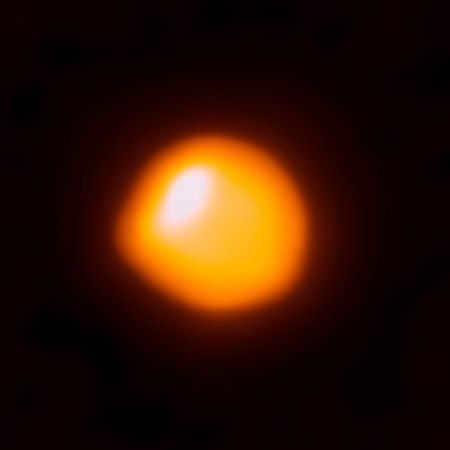
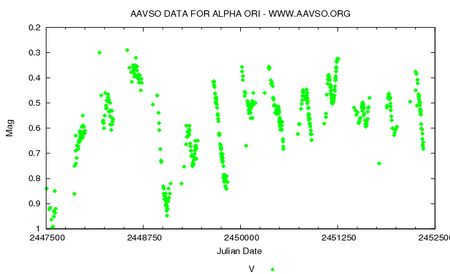
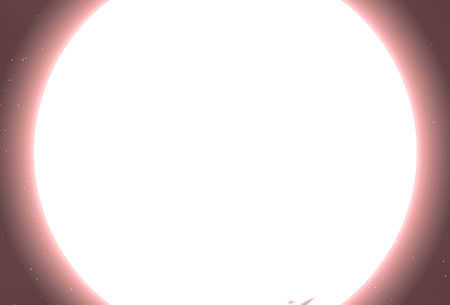
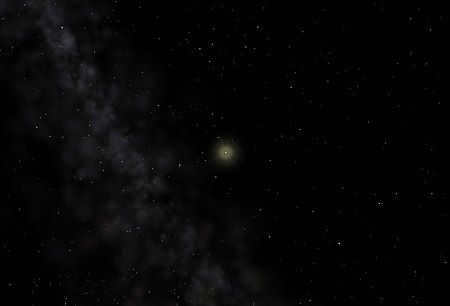
It’s an inconsistent star [13]. From 1993 to 2009, the star’s diameter decreased by 15%, from 5.5 to about 4.7 AU, and by 2011, it had decreased to 4.5 AU. The reason behind this phenomenon still puzzles astronomers [32] [33]. However, the brightness of the star remained unchanged throughout this period [34] [35].
The observed decrease in Betelgeuse’s radius could also be attributed to possible misinterpretation of the data. For instance:
- The disparities in brightness across different parts of the star’s surface. These inhomogeneities shift due to rotation, leading to apparent changes in brightness, which can be mistakenly interpreted as changes in diameter.
- Scientists have suggested that modeling of supergiant stars indicates that they may have a nonspherical shape, resembling an irregularly shaped potato. Observations of Betelgeuse, for example, suggest that it may have a rotation period of 18 years, even though telescopes have only observed it for less than one complete revolution around its axis [36].
- It is possible that what scientists observe is not the true diameter of the star, but rather a layer of dense molecular gas that creates the illusion of the star’s size changing.
Charles Townes, a Nobel Prize winner, monitored Betelgeuse in an attempt to understand the cause of its changing diameter. He used a specialized spectrometer and interferometer to enhance his observational capabilities [37]. [What is the significance of this fact?]
For a significant period, the gas nebula surrounding the star remained unseen due to its concealment by the star’s illuminating light [32].
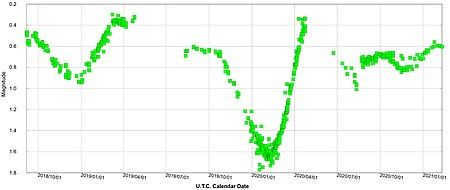
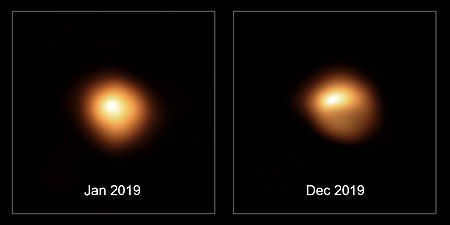
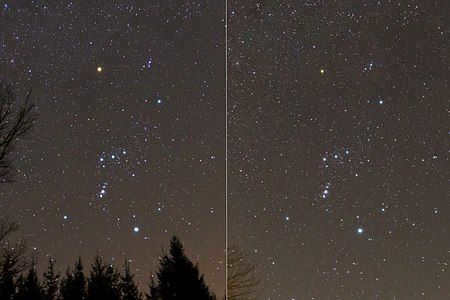
Starting from October 2019, the star’s brightness started to decline, and by December 7, 2019, it reached an apparent stellar magnitude of +1.12 m [38]. In mid-December, its brightness further decreased to values of +1.273, +1.294, and +1.286 m [39].
On January 6, 2020, the apparent brightness of Betelgeuse dropped to a magnitude of +1.4 m [43]. In January 2020, Betelgeuse dimmed to +1.494 m, +1.506 m [44] [45], and +1.614 +/-0.012 m [46]. In February, it further dimmed to +1.66 m [47] [48]. From February 7 to 13, 2020, the star’s brightness remained at 1.614 m. On February 17, 19, and 20, 2020, Betelgeuse reached magnitudes of +1.589 m, +1.567 m, and 1.555 m, respectively. By February 22, 2020, its brightness increased to +1.522 m. Therefore, the current fading episode aligns with the expected duration of the previous photometry’s constant period of 420-430 days [49].
In June 2020, researchers from the Institute for Astronomy of the Max Planck Society in Germany revealed that Betelgeuse is covered by massive sunspots, which contribute to the star’s fluctuating brightness. This finding contradicts the earlier hypothesis of dust cloud emissions [50] [51].
Ground-based telescopes have confirmed on June 16, 2021 that the Betelgeuse’s Great Darkening, which took place a few years ago, was indeed the result of a dust cloud formed by the ejection of plasma from the star’s photosphere [52] [53].
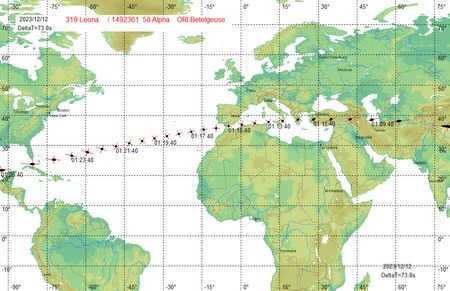
The star Betelgeuse is predicted to be eclipsed by the asteroid (319) Leon on December 12, 2023. The size of the eclipse will depend on the pulsation phase of Betelgeuse, with the asteroid either completely covering the star or only partially covering it. This event will be observed [54].
The future of the stellar [ edit edit code ] .
Related articles [ edit correct code ] .
Important details [ edit correct code ]
- ↑ In a 1978 paper, Chinese scholars discuss the following excerpt from the Treatise: Chinese. 太白白,比狼;赤,比心;黄,比参左肩;苍,比参右肩 .
- ↑ 12 van Leeuwen, F (November 2007). “Hipparcos, the New Reduction”. Astronomy and Astrophysics. VizieR. 474 (2): 653-664. arXiv: 0708.1752 . Bibcode:2007A&A. 474..653V. DOI:10.1051/0004-6361:20078357. S2CID18759600.
- ↑ 123456Meridith Joyce, Shing-Chi Leung, László Molnár, Michael J. Ireland, Chiaki Kobayashi.By building upon the work of previous researchers, new calculations for the mass and distance of Betelgeuse have been obtained using a combination of evolutionary, asteroseismic, and hydrodynamical simulations with MESA. This research was published in The Astrophysical Journal on October 13, 2020, in volume 902, issue 1, on page 63. The article is available online with ISSN 1538-4357 and doi:10.3847/1538-4357/abb8db. Archived on October 21, 2020.
- ↑VSX : Detail for alf Ori(n.e.) . www.aavso.org. Accessed on May 17, 2022.Archived on March 11, 2022.
- ↑ Famaey, B.; Jorissen, A.; Luri, X.; Mayor, M.; Udry, S.; Dejonghe, H.; Turon, C. (2005). “Revisiting the concept of superclusters: Local kinematics of K and M giants from CORAVEL/Hipparcos/Tycho-2 data”. Astronomy and Astrophysics. 430: 165—186. arXiv:stro-ph/0409579. Bibcode:2005A&A. 430..165F. DOI:10.1051/0004-6361:20041272. S2CID17804304.
- ↑ 12G. M. Harper, A. Brown, E. F. Guinan, E. O’Gorman, A. M. S. Richards. “An Updated 2017 Astrometric Solution for Betelgeuse” // The Astronomical Journal. — 2017-07-01. — Vol. 154. — P. 11. — ISSN 0004-6256. — doi:10.3847/1538-3881/aa6ff9. Archived on April 10, 2022.
- ↑ Lambert, D.L.; Brown, J.A.; Hinkle, K.H.; Johnson, H.R. (September 1984). “Abundances of carbon, nitrogen, and oxygen in Betelgeuse”. Astrophysical Journal [Eng.]. 284: 223—237. Bibcode:1984ApJ. 284..223L. DOI:10.1086/162401. ISSN0004-637X.
- ↑Philip C. Keenan, Raymond C. McNeil.The Perkins Catalog of Revised MK Types for the Cooler Stars // The Astrophysical Journal Supplement Series. — 1989-10-01. — Vol. 71 . — p. 245 . — ISSN0067-0049. — doi:10.1086/191373. Archived June 1, 2022.
- ↑ 12 Nicolet, B. (1978). “Catalogue of Homogeneous Data in the UBV Photoelectric Photometric System”. Astronomy & Astrophysics. 34: 1—49. Bibcode:1978A&AS. 34. 1N.
- ↑N. N. Samus, E. V. Kazarovets, O. V. Durlevich, N. N. Kireeva, E. N. Pastukhova.VizieR Online Data Catalog: General Catalogue of Variable Stars (Samus+, 2007-2017) // VizieR Online Data Catalog. — 2009-01-01. — С. B/gcvs . Archived on March 6, 2022.
- ↑ 12345Dolan, Michelle M.; Mathews, Grant J.; Lam, Doan Duc; Lan, Nguyen Quynh; Herczeg, Gregory J.; Dearborn, David S. P. Evolutionary Tracks for Betelgeuse (English) // The Astrophysical Journal : journal. — IOP Publishing, 2017. — Vol. 819 , no. 1 . — P. 7 . — doi:10.3847/0004-637X/819/1/7. — Bibcode: 2016ApJ. 819. 7D . — arXiv:1406.3143v2.
- ↑Pierre Kervella, Leen Decin, Anita M. S. Richards, Graham M. Harper, Iain McDonald.Properties of the molecular envelope and rotational velocity of Betelgeuse determined using ALMA(English) // Astronomy & Astrophysics. — 2018-01-01. — Vol. 609 . — P. A67 . — ISSN1432-0746 0004-6361, 1432-0746. — doi:10.1051/0004-6361/201731761. Archived on April 17, 2021.
- ↑Prugniel P., Vauglin I., Koleva M.Atmospheric parameters and spectral interpolator for MILES stars (English) // Astronomy and Astrophysics / T. Forveille — EDP Sciences, 2011. — Vol. 531. — P. 165–165. — ISSN 0004-6361; 0365-0138; 1432-0746; 1286-4846 — doi:10.1051/0004-6361/201116769 — arXiv:1104.4952
- ↑ 123Encyclopedia Britannica, 2005.
- ↑Betelgeuse star (English). Encyclopedia Britannica. Date accessed: December 4, 2019.Archived August 22, 2019.
- ↑ 12 Jim Kaler. Betelgeuse (Alpha Orionis)(unverified) . Archived from the original on December 16, 2008.
- ↑ Joyce, Meridith; Leung, Shing-Chi; Molnár, László; Ireland, Michael; Kobayashi, Chiaki; Nomoto, Ken’Ichi (2020). “Standing on the Shoulders of Giants: New Mass and Distance Estimates for Betelgeuse through Combined Evolutionary, Asteroseismic, and Hydrodynamic Simulations with MESA”. The Astrophysical Journal. 902 (1): 63. arXiv: 2006.09837 . Bibcode:2020ApJ. 902. 63J. DOI:10.3847/1538-4357/abb8db. S2CID221507952.
- An Updated 2017 Astrometric Solution for Betelgeuse(neop.) . Archived on October 11, 2018.
- H. R. Neilson, J. B. Lester, X. Haubois.Weighing Betelgeuse: Measuring the Mass of α Orionis from Stellar Limb-darkening. — 2011-12-01. — Vol. 451 . — p. 117 . Archived on March 7, 2021.
- New photographs reveal giant bubbles on Betelgeuse(neop.) . Lenta.ru (July 30, 2009). Accessed: August 13, 2010.Archived on December 20, 2010.
- Kunitzsch, P.; Smart, T. A Dictionary of Modern star Names: A Short Guide to 254 Star Names and Their Derivations. — 2nd ed., rev. and sup. — Cambridge, MA: Sky Pub., 2006. — ISBN 9781931559447.
- Allen, Richard Hinckley (1963). Star Names: Their Lore and Meaning (Revised edition).
- ↑A. A. Michelson, F. G. Pease.Measurement of the diameter of alpha Orionis with the interferometer(English) // The Astrophysical Journal. — IOP Publishing, 1921-05-01. — Vol. 53 . — ISSN0004-637X. – doi:10.1086/142603. Archived July 27, 2013.
- ↑Hu Shuren, Wang Jianmin, Liu Jinyi. On the color variation of Betelgeuse over two thousand years (Chinese) // Collection of Science and Technology History (1). – Shanghai: Shanghai Scientific and Technological Publishing House, 1978. – pp. 75-78 .
- ↑Sima Qian.Treatise on celestial phenomena // Historical Notes = Records of the Grand Historian/Volume 027 (Chinese)..
- ↑Ponyatov, 2020, p. 25.
- ↑The surface structure and limb-darkening profile of Betelgeuse(unpublished). . Date of access: June 5, 2007.Archived from the original on January 15, 2000.
- ↑E. O’Gorman, P. Kervella, G. M. Harper, A. M. S. Richards, L. Decin, M. Montargès, and I. McDonald.The non-uniform sub-millimeter atmosphere of Betelgeuse(English) // arxiv.org : pdf. – 2017. – June 19. Archived September 12, 2017.
- ↑ALMA (ESO/NAOJ/NRAO)/E. O’Gorman/P. Kervella.ALMA has captured images of the surface of Betelgeuse(unpublished)(unavailable link – history). www.eso.org (June 26, 2017). – This orange bubble is our neighboring star Betelgeuse, captured by the Atacama Large Millimeter/submillimeter Array (ALMA) telescope. These are the first observations of the star’s surface made by ALMA, and the initial attempt achieved a higher resolution than all previous observations of Betelgeuse. Archived June 30, 2017.
- ↑It is possible that the renowned star Betelgeuse assimilated a companion star approximately 100,000 years ago(not yet published). . www.astronews.ru. Accessed January 17, 2019.Archived January 19, 2019.
- ↑J. M. Fowler, J. M. Sullivan, M. Koutoulaki, L. Zhou, J. Hickey.The Betelgeuse Project: limitations arising from rotation(written in English) // Monthly Notices of the Royal Astronomical Society. – Oxford University Press, 2017-03-01. – Vol. 465 , iss. 3 . – P. 2654-2661 . – ISSN0035-8711. – doi:10.1093/mnras/stw2893. Archived January 19, 2019.
- ↑The luminous star Betelgeuse may be concealing a profound, enigmatic secret(not yet published). . Date of access: January 26, 2020.Archived January 31, 2020.
- ↑ 12Science News – R&D.CNews(unpublished)(unavailable link -. History). www.rnd.cnews.ru. Date of access: July 1, 2017.
- ↑Computera: How can we revive people’s diplomacy? (Russian) science.compulenta.ru. Date of access: July 1, 2017.Archived from the original on March 30, 2013.
- ↑Popular Giant Star Shrinks Mysteriously(unpublished) . Space.com.. Date of access: July 1, 2017.Archived March 27, 2010.
- ↑Changes in Betelgeuse’s diameter with time(unpublished). . Astronet (June 30, 2009). Date of access: September 29, 2010.Archived from the original on January 28, 2013.
- ↑Betelgeuse: Is the Remarkable Star Shrinking?(unpublished). NewScientist (June 10, 2009). Archived August 24, 2011.
- ↑C. H. Townes, E. H. Wishnow, D. D. S. Hale, B. Walp.A Systematic Change with Time in the Size of Betelgeuse(English) // The Astrophysical Journal. – IOP Publishing, 2009-06-01. – Vol. 697 . – P. L127-L128 . – ISSN2041-8205.
- ↑Guinan E. F., Wasatonic R. J., Calderwood T. J.The Fainting of the Nearby Red Supergiant BetelgeuseApxive copy of 29 Dec 2019 at the Wayback Machine, 8 Dec 2019
- ↑Updates on the "Fainting" of BetelgeuseApxived copy from December 30, 2019 at the Wayback Machine, 23 Dec 2019
- ↑ ESO's VLT telescope has captured images of the surface of Betelgeuse during its fainting episodeArchived copy dated February 15, 2020 at the Wayback Machine, February 14, 2020.
- ↑Astronomers are now questioning the imminent demise of Betelgeuse as new images show it fading away(uncaptioned). Accessed on February 16, 2020.Archived on February 16, 2020.
- ↑An unpublished photoportrait of the faded Betelgeuse is available. Date of access: February 16, 2020.Archived on February 16, 2020.
- ↑Alert Notice 690: Betelgeuse (alpha Ori) experiences a rare very faint minimum. Archived on January 7, 2020 at the Wayback Machine, January 6, 2020.
- ↑The fading of Betelgeuse continues, unprecedented in its nature. Copyedited on January 26, 2020 at the Wayback Machine, January 20, 2020.
- ↑Betelgeuse is still dimming! It’s now at a magnitude of 1.506. (not available). . Accessed on January 26, 2020.Archived on January 26, 2020.
- ↑Betelgeuse Updates. ATel #13439; Edward F. Guinan and Richard J. Wasatonic (Villanova University)on 1 Feb 2020; 23:20 UT(unpublished). . Date of access: February 14, 2020.Archived February 15, 2020.
- ↑THE CONTINUING MYSTERY OF BETELGEUSE, Sunday, Feb. 9, 2020
- ↑The possibility of Betelgeuse going supernova will be revealed by February 21stCopyedited March 7, 2020 at the Wayback Machine, February 10, 2020.
- ↑The Change in Brightness of BetelgeuseCopyedited February 25, 2020 at the Wayback Machine, February 22, 2020.
- ↑Giant spots have been discovered on the surface of the star Betelgeuse.(unpublished) . TASS Science (June 29, 2020). Date of access: June 29, 2020.Archived June 29, 2020.
- ↑ Dharmawardena, Thavisha E.; Mairs, Steve; Scicluna, Peter; Bell, Graham; McDonald, Iain; Menten, Karl; Weiss, Axel; Zijlstra, Albert (2020-06-29). “Betelgeuse Shows Dimmer Signal in the Submillimeter as Well: A Detailed Analysis of JCMT and APEX Monitoring during the Recent Optical Minimum”. The Astrophysical Journal. 897 (1): L9. DOI:10.3847/2041-8213/ab9ca6. ISSN2041-8213.
- ↑The Dust Hypothesis of the Great Darkening of Betelgeuse Confirmed by Ground-based Telescopes(unpublished). . European Southern Observatory (June 16, 2021). Date of Access: June 18, 2021.Archived on June 18, 2021.
- Ground-based telescopes have confirmed the theory that the Great Darkening of Betelgeuse was caused by dust(unpublished). . N + 1 (June 16, 2021). Accessed June 18, 2021.Archived June 18, 2021.
- Alpha Orion (Betelgeuse) experiences its lowest brightness in 30 yearsArchived January 26, 2021 at the Wayback Machine, 07/12/2019
- Croswell Ken.Inner Workings: A massive star dies without a supernova, revealing the delicate nature of supernovae(English) // PNAS. — 2020. — 21 January ( vol. 117 , no. 3 ). — P. 1240—1242 .
- Oktsana Gribanova.Scientists comment on the news of the appearance of a second Sun // Russian Gazette. — 2016. — May 18. Archived December 31, 2019.
- ↑ 12Plait, Phil.When Will Betelgeuse Explode?(English) // Slate : magazine. — 2014. — 8 September. Archived December 29, 2019.
- ↑ 12It will explode at any moment. Astronomers have talked about the future of Betelgeuse. Archived on April 12, 2020 on Wayback Machine // RIA Novosti, April 12, 2020
- ↑Sanders, Robert.Red Giant Star Betelgeuse Mysteriously Shrinking(unconfirmed) . UC Berkeley News. UC Berkeley (June 9, 2009). Accessed: April 18, 2010.Archived May 27, 2010.
- ↑Red Giant Star Betelgeuse in the Constellation Orion is Mysteriously Shrinking(English) // Astronomy Magazine : magazine. — 2009.
- Plait, PhilIs Betelgeuse on the verge of exploding?(unpublished).Bad Astronomy. Discovery (June 1, 2010). Date of access: September 14, 2012.Archived April 21, 2011.
- O’Neill, Ian. Don’t worry! Betelgeuse will not explode in 2012!, Discovery space news (January 20, 2011). Archived January 23, 2011.Date of access: September 14, 2012.
- Plait, PhilBetelgeuse and 2012(unpublished). . Bad Astronomy. Discovery (January 21, 2011). Date of access: September 14, 2012.Archived November 3, 2012.
Literature [ edit edit code ].
- Betelgeuse // “Banquet Campaign” 1904 – Bolshoi Irgiz. – Moscow : Bolshaya Rossiyskaya Encyclopedia, 2005. – С. 434. – (Big Russian Encyclopedia : [in 35 vol.] / editor-in-chief. YU. Osipov ; 2004-2017, vol. 3). – ISBN 5-85270-331-1.
- Ponyatov A. Gigantic. Critical days of Betelgeuse // Science and Life. – 2020. – № 4. – С. 19-26.
- Orion, constellation // The Encyclopedic Dictionary of Brockhaus and Efron : in 86 vol. (82 vol. and 4 supplements). – St. Petersburg. , 1890-1907.
References [ edit edit code ]
- Surface imaging of Betelgeuse with COAST and the WHT . Archived from the original on June 14, 2007.
- ALMA has captured the most intricate picture of Betelgeuse to date(unpublished) . in-space.ru. Date of access: March 1, 2020.
- Betelgeuse: the clearest image of Betelgeuse(unpublished) . Astronet. Date of access: March 1, 2020.
- How to witness a supernova outburst. Betelgeuse won’t explode on YouTube
Betelgeuse, the most luminous star in the Orion constellation, has recently experienced a significant decline in brightness, much like hundreds of other stars in the night sky. This occurrence has sparked intense excitement and debate, as the fate of Betelgeuse has been predicted to be its demise in a brilliant supernova explosion, anticipated to occur within the next few thousand years.
There is a possibility that the explosion of Betelgeuse could occur either today, tomorrow, or even in a millennium. The precise timing of this event remains unpredictable, which is why the significant decrease in brightness of this particular star is generating such extensive discussion. It is evident that something is occurring within Betelgeuse, making it a topic of great interest. Therefore, it is worth examining this phenomenon more closely, as it has the potential to become one of the most prominent occurrences of the century, quite literally.
The presence of Betelgeuse in the sky
When gazing at the winter night sky, one cannot help but notice a striking and unforgettable figure in the southern region, adorned with a belt of three stars. This magnificent sight is none other than the constellation of Orion, known for its brilliance and captivating features. Orion graces the sky from October, making its appearance in the southeast, and gracefully exits in April, bidding adieu in the west.
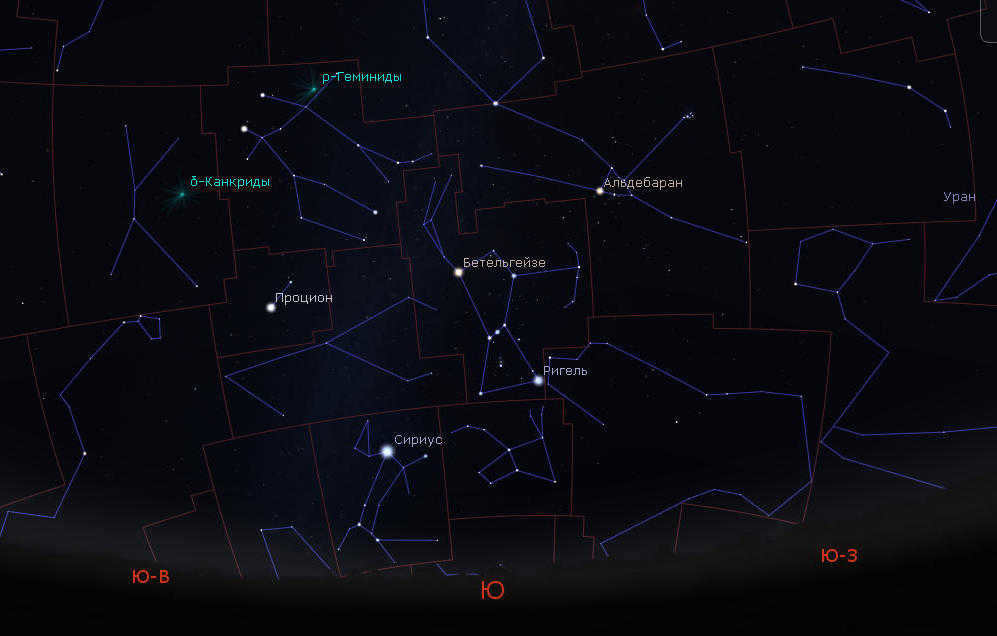
During the winter season, one can easily spot the constellation Orion and its prominent star, Betelgeuse. This star, located in the upper left region of the constellation, exhibits a reddish hue. Despite its red appearance, Betelgeuse is classified as a red supergiant. Its distinctive color makes it a standout object in the night sky.
Interestingly, the brightness of Betelgeuse is not constant. It fluctuates between magnitudes 0.0 and +1.2. This variability is a result of the star’s pulsations, which cause changes in its size. Astronomers have long recognized this behavior, hence designating Betelgeuse as a variable star. Even during its dimmest phase, Betelgeuse remains one of the most luminous stars in our celestial surroundings.
What is currently known about Betelgeuse
In reality, there is a limited amount of information available regarding this particular star. The challenge lies in accurately measuring its distance. Due to its significant distance from Earth, the annual parallax method is largely ineffective in this case. Furthermore, Betelgeuse does not have a companion star, which would have aided in determining its distance. Nonetheless, obtaining this measurement is crucial as it serves as a foundation for calculating numerous other characteristics. Scientists currently estimate that Betelgeuse is situated approximately 650 light years away.
Betelgeuse is renowned for being one of the most massive stars in the scientific community. Throughout its pulsations, this supergiant has the ability to fluctuate in size, ranging from 500 to 800 times the size of our Sun. Based on certain calculations, Betelgeuse is estimated to be 1,200 times larger than our Sun. Its volume could accommodate an astonishing 300 million stars similar to our Sun! Furthermore, if Betelgeuse were positioned at the center of our solar system, it would engulf all the planets, including Mars, and potentially expand to encompass Jupiter.
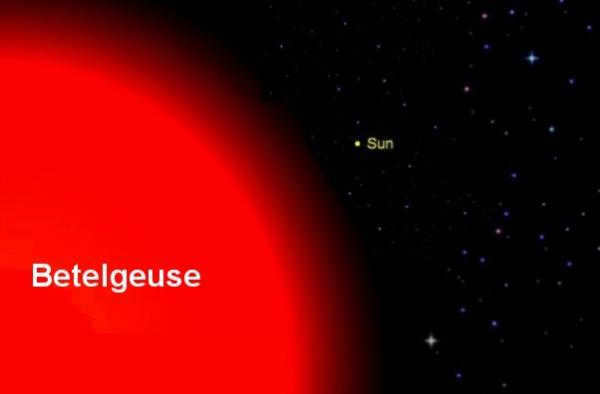
The Sun and Betelgeuse can be compared in terms of their size. Due to the enormous size of Betelgeuse, scientists have been able to capture images of its disk and even observe spots on its surface. The angular diameter of Betelgeuse was first measured in 1920 and it averages 0.047″, although this measurement is subject to constant change.
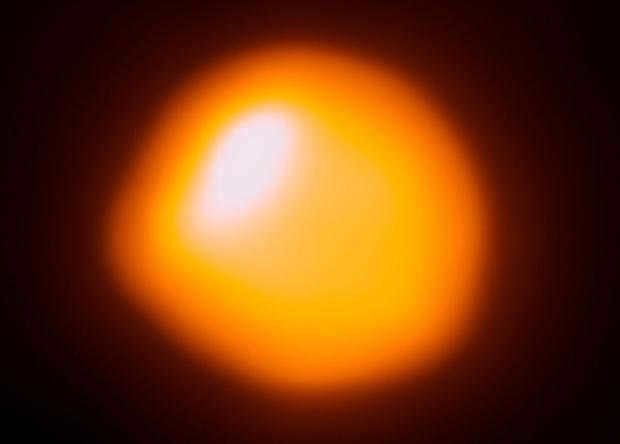

A photo showcasing Betelgeuse, taken by the ALMA telescope.
Understanding the Variations in Betelgeuse’s Brightness
Betelgeuse experiences pulsations, which are accompanied by synchronous changes in the amount of light it emits. As the star expands, its emitting surface significantly increases, and then subsequently decreases. At its lowest point, Betelgeuse emits light that is 80,000 times brighter than the Sun, while at its peak, it emits light that is 105,000 times brighter.
This particular star is classified as a semi-regular variable, meaning that its brightness changes in an unpredictable manner, yet there is a consistent period of approximately 420-430 days. Typically, the brightness ranges from 0 to 1.2 m.
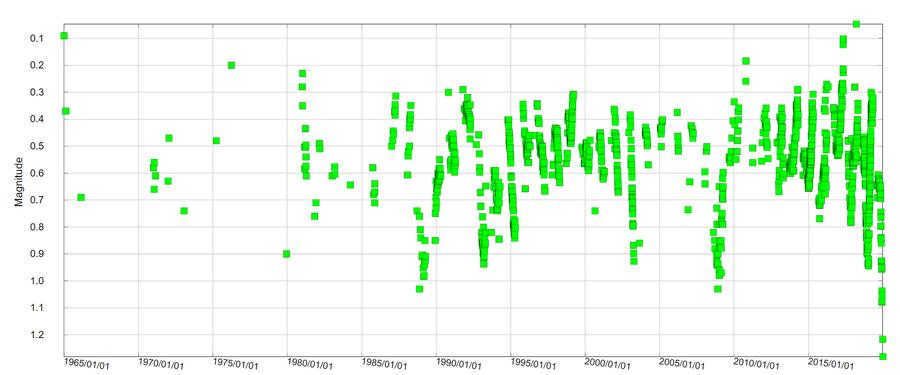
The brightness of Betelgeuse has fluctuated over the past 50 years, reaching a record low in 2020.
Red supergiants, like Betelgeuse, have a unique characteristic of pulsation. This pulsation is caused by instability within the star. When the star becomes compressed, the pressure and temperature increase, causing it to expand. As it reaches a larger size, the outer envelope becomes thinner and more transparent, allowing radiation to pass through more easily. Eventually, the surface cools and the star begins to shrink again due to gravity. This cycle repeats, causing fluctuations in size and, consequently, changes in brightness.
Nevertheless, the pulsations of the star and its cyclical expansions are not indicative of any extraordinary events occurring within its inner layers, as all the associated processes take place in the upper regions.
There was a recent occurrence of the most significant decrease in brightness ever recorded – during the late months of 2019 and the early months of 2020. This event generated a lot of excitement and speculation, with many anticipating that Betelgeuse would ultimately explode. However, contrary to these expectations, the star did not undergo any explosive transformation. The decline in brightness commenced in October and by January 4th, it had reached a level of +1.4 m, which is above the normal range. In December, astronomers utilizing the Very Large Telescope were able to observe changes in the star’s disk shape. It is believed that Betelgeuse emitted powerful stellar dust, which dispersed in the direction of Earth, causing a significant reduction in the star’s light output. The presence of dust clouds near Betelgeuse was confirmed in December 2019 through the use of a spectrometer.
The destiny of Betelgeuse
The lifespan of Betelgeuse, a red supergiant star, is relatively short. This phenomenon occurs when a star has a mass exceeding 10 times that of our Sun and has already depleted its hydrogen fuel. At this stage, helium fusion takes place, causing the temperature in the star’s core to rise to billions of degrees. Consequently, carbon nuclei begin fusing, resulting in the formation of magnesium, neon, and oxygen. Over time, various elements accumulate and undergo reactions, ultimately leading to the creation of an iron core, marking the culmination of these processes.
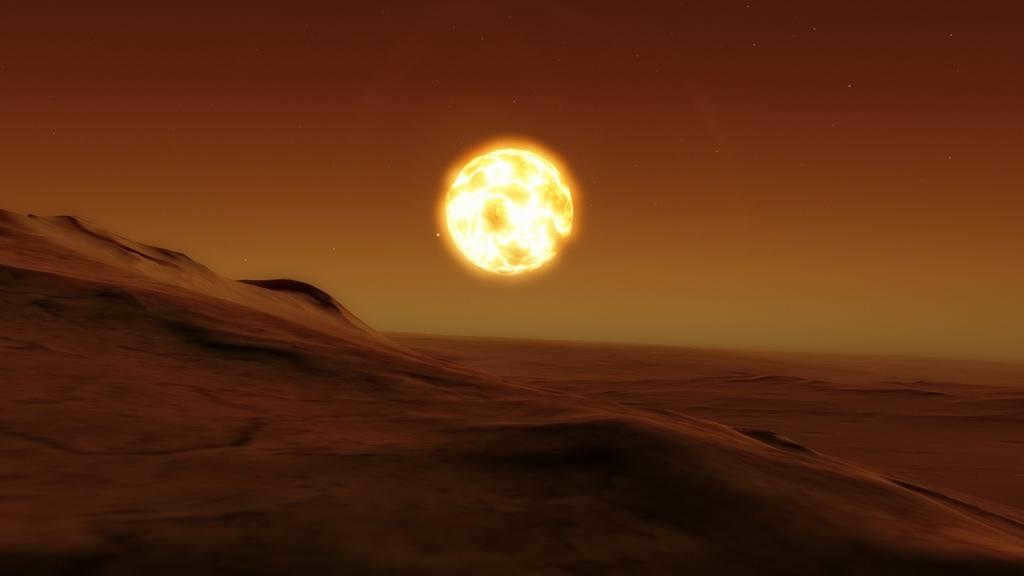
Betelgeuse observed from a distance of 28 astronomical units.
Once the formation of iron commences, the fusion process of nuclei shifts from energy release to energy absorption, signaling the imminent end of the star. The iron core occupies the star’s center, rendering the nearby nuclear reactions incapable of sustaining the star’s luminosity. Consequently, its stability is disrupted, ultimately leading to its collapse under the relentless force of gravity. A powerful shockwave ensues, dispersing the remnants of the star into the surrounding space, resulting in a supernova eruption. The catastrophic aftermath can give rise to either a black hole or a neutron star.
This is the destiny that Betelgeuse is bound for. We cannot state with certainty the exact stage it is currently in. However, what we do know is that it has already exhausted its hydrogen and helium fuel long ago, and for several thousand years now, it has been utilizing carbon and synthesizing magnesium. It is a challenge to determine the duration of this particular phase, but one thing remains evident – each subsequent phase will progress at an increasingly accelerated pace.
To put it differently, the carbon combustion process will only take a few thousand years, and following that, the phases will transition in just hundreds of years. The formation of an iron core will occur rapidly, and at any given moment, Betelgeuse will undergo a supernova explosion. It is highly plausible that the accumulation of iron within the star’s core is already underway.
How can we determine if Betelgeuse undergoes a supernova?
When the event occurs, it will be unmistakable – the resulting supernova will outshine all other stars in the night sky. Its luminosity will reach -9 m, making it as bright as the moon. It may even be visible during daylight hours. Additionally, it will emit a significant amount of X-ray radiation, although its intensity will be much lower compared to that of the Sun. Rest assured, there is no threat to Earth under any circumstances.
However, is it possible to predict Betelgeuse’s imminent explosion? The answer is yes – through the detection of neutrino signals. Neutrinos have the unique ability to pass through the star’s dense layers without any hindrance, and scientists have developed specialized detectors capable of capturing these elusive particles.
So, when Betelgeuse begins to contract and transform into a neutron star, it will reach scorching temperatures of 10 billion degrees Celsius. This will result in an extraordinary release of energy, with the majority being carried away by a formidable stream of neutrinos. The remarkable aspect of these particles is that they encounter no obstacles, allowing them to reach Earth at an unparalleled speed compared to other forms of radiation.
Naturally, the entire process will be incredibly turbulent and rapid, and we will only be able to detect the surge of neutrinos from Betelgeuse a mere 3-7 days before the supernova eruption takes place.
That’s the nature of this celestial entity – the crimson supergiant known as Betelgeuse, alpha Orionis. Take a moment to locate it in the night sky, because in cosmic terms, its existence is rapidly drawing to a close. However, the demise of this star will be nothing short of awe-inspiring, destined to become the stuff of legends.
Betelgeuse (also known as α Orion or α Ori) is a highly luminous star located in the constellation of Orion. This red supergiant star exhibits a semi-regular pattern of variability, with its brightness ranging from 0.2 to 1.2 magnitude and averaging around 0.7 m. The distinctive red hue of Betelgeuse can be easily observed with the naked eye, and its color index (B-V) is measured at 1.86 m. In terms of luminosity, Betelgeuse’s minimum value is approximately 80,000 times that of the Sun, while its maximum value is around 105,000 times [2]. Astronomers have estimated the distance to Betelgeuse to be between 495 and 640 light years [2]. This star is known for its immense size, ranking among the largest stars in existence. In fact, if Betelgeuse were to replace the Sun, it would extend beyond the orbit of Mars at its smallest size and reach the orbit of Jupiter at its largest size.
Current estimates suggest that the angular diameter of Betelgeuse is roughly 0.055 angular seconds[3]. Assuming that Betelgeuse is located 570 light-years away, its diameter would be approximately 950-1000 times larger than that of the Sun. Moreover, Betelgeuse boasts a mass of about 17 solar masses[4].
This celestial body goes by other monikers:
- "Ad-Dira" ("the appendage"),
- "Al-Manqib",
- "Al-Yad al-Yamma",
- "Ardra, Nakshatra,
- "Bahu",
- "Bashn" (Persian, "hand"),
- "Gula" (Euphrates valley),
- "Claria" (Coptic language, "bandage").
Main characteristics
Astronomers find several intriguing features about Betelgeuse. It stands out as one of the pioneering stars to have its angular diameter measured from Earth using an astronomical interferometer. In the measurements conducted by Michelson and Pease on December 13, 1920, Betelgeuse exhibited an angular diameter of 0.047″ [7]. Subsequent observations revealed that this value is not constant, but rather fluctuates. While the precise distance to Betelgeuse remains uncertain, if it is assumed to be 650 light-years away, the star’s diameter varies between 500 and 800 times that of the Sun during its pulsations.
It is difficult to determine the exact diameter of Betelgeuse because its brightness decreases gradually as you move away from the center of the disk. The color of the emitted light also changes with distance. Despite being only 17 times more massive than the Sun, Betelgeuse has a volume that is 300 million times larger. Betelgeuse was the first star, after the Sun, for which images of its disk and spots were captured. These images were obtained using telescopes operating in the aperture-diaphragm interferometry mode and were later observed in more detailed images taken by the COAST telescope [8].
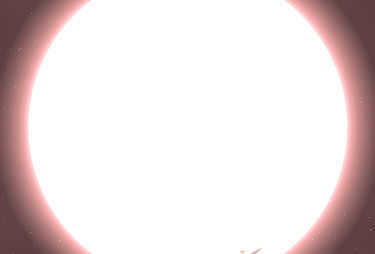
A stunning depiction of Betelgeuse as seen from a remarkable distance of about 8 astronomical units, created with the power of computer-generated imagery.
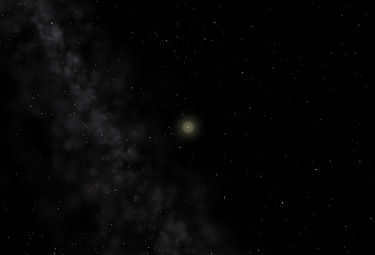
It should be noted that over the period of observation from 1993 to 2009, the size of the star decreased by 15%, going from 5.5 to approximately 4.7, and by 2011 to 4.5 astronomical units, and astronomers are still unable to explain the reason behind this [9] [10]. Meanwhile, the brightness of the star has not shown any noticeable change during this time [11] [12].
The observed decrease in Betelgeuse’s radius could also be attributed to a misinterpretation of the collected data, such as:
- variations in brightness across different regions of the star’s surface; these inhomogeneities shift due to rotation, resulting in apparent changes in luminosity. These changes may be mistakenly interpreted as changes in diameter.
- It is possible that scientists may not be accurately measuring the actual size of the star, but rather a layer of dense molecular gas that gives the illusion of a change in size.
Nobel Prize laureate Charles Townes intends to continue monitoring Betelgeuse in hopes of discovering patterns in the fluctuations of its diameter and understanding their underlying cause. He plans to utilize a specialized spectrometer for the interferometer to enhance observational capabilities[14].
There exists a gas nebula surrounding the star which has long been concealed by the star’s luminosity [9].
The destiny of the celestial body
Confirmation of facts is crucial for the credibility of information, as any unverified claims can be subject to doubt and removal.
Feel free to enhance this article by including references to reputable sources.
This milestone was established on May 12, 2011.
The most probable outcome for the culmination of the star’s lifecycle is that Betelgeuse will ultimately experience a Type II supernova explosion, although there is a possibility that the star will not detonate and will instead shed its outer layers, forming a planetary nebula and leaving behind a rare oxygen-neon white dwarf. Astronomers are divided on the timeframe remaining before this event. While Betelgeuse is relatively young, at approximately 10 million years old, some experts believe that its current variability suggests it is already in the carbon burnout phase and will therefore undergo a supernova explosion within the next one or two thousand years. On the other hand, other scientists posit that it will endure for a much longer duration.
Nevertheless, there is a consensus that such a supernova event would be a momentous astronomical occurrence. However, due to its considerable distance from Earth, it would not pose a significant threat to life on our planet.
If an explosion were to occur, Betelgeuse could experience a significant increase in brightness, shining as brightly as a crescent moon and potentially increasing its luminosity by at least 10,000 times. According to some sources, the explosion could result in a maximum stellar magnitude equivalent to that of a full moon (-12.5 m). This extraordinary event would last for several months, during which the star would resemble a brilliant point of light, as radiant as the full moon and emitting a vibrant, glass-like glow during nighttime. Additionally, the star would be easily discernible even in daylight. However, over the course of a few months or years, the star’s luminosity would gradually fade, eventually rendering it invisible to the naked eye. As a consequence, Orion’s right shoulder would momentarily vanish, only to be replaced by a nebula after several centuries.
Nevertheless, in the event that one of Betelgeuse’s poles is aligned in the direction of Earth, there will be notable consequences. A beam of gamma rays and various other celestial particles will be aimed directly at our planet. This will result in intense auroras and potentially a quantifiable reduction in the ozone levels within the ozone layer, leading to negative impacts on life on Earth. Additionally, if the star’s axis is positioned towards us in relation to the solar system, the flare will be significantly brighter compared to when it is pointing away.
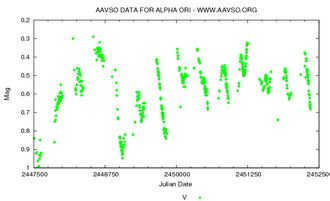
During excavations in 1980, Shu-zhen, Jianmin, and Jin-yi discovered ancient Chinese reports dating back to the first century BC, revealing that Betelgeuse’s color was either white or yellow. However, Ptolemy, in 150 AD, described the star as red. Chinese astrophysicist Fang Lizhi proposed that Betelgeuse may have transformed into a red giant star during that period. It is known that stars change color from white to yellow to red as they deplete the hydrogen in their cores. Shu-zhen further speculated that Betelgeuse’s color change may have occurred when it shed its shell of dust and gas, which is still visible today and continues to expand. If their theory holds true, it is unlikely that Betelgeuse will imminently undergo a supernova because stars typically remain red giants for tens of thousands of years.
Betelgeuse in literature
Verification is essential for information to be considered reliable and not subject to scrutiny or removal.
To enhance the credibility of this article, you have the option to insert citations from reputable sources.
This particular edit was made on May 12, 2011.
- Ford and Zaphod Beeblebrox, characters from Douglas Adams’ novel “Hitchhiker’s Guide to the Galaxy,” hailed from “a small planet somewhere around Betelgeuse.”
- Frank Herbert’s “Dune Chronicles” series features a planetary system referred to as Bell Tegez, which is likely a distorted version of Betelgez.
- Kurt Vonnegut’s 1959 story “The Sirens of Titan” portrays Winston Niles Rumford and his canine companion Cossack as the “Branwydn Phenomenon,” a journey that commences on the Sun and concludes on Betelgeuse.
- In Pierre Boule’s “Planet of the Apes,” humans traverse from Earth to Betelgeuse and eventually arrive on the planet Sorora.
- The novel “Rebellion at Betelgeuse” by Andrei Egorov and Evgeny Garkushev features a galactic colony of space convicts in the Betelgeuse star system.
- In August Derleth’s Lovecraftian horror story “The Dweller in Darkness,” Betelgeuse is mentioned as the dwelling place of the Elder Gods from the Cthulhu mythology by G.F. Lovecraft.
- R.G. Gélazny’s story “The Light of the Obscure” revolves around an artificially created planet near Betelgeuse.
- In Gerard Klein’s novel “Star Gambit,” a government planet is situated near Betelgeuse and becomes the new capital for humanity.
- Arseny Tarkovsky’s poem “The Star Catalog” mentions the hero being “answered by Orion’s alpha.”
For more information
Important details
- ↑– scientists have determined the weight of Betelgeuse
- ↑ 123 Jim Kaler. Betelgeuse (Alpha Orionis).
- ↑Weiner et al, 2000.
- ↑New pictures uncover huge bubbles on Betelgeuse. Lenta.ru (July 30, 2009). Archived from the original source on August 24, 2011.Checked August 13, 2010.
- ↑Kunitzsch, P.; Smart, T. A Dictionary of Modern star Names: A Short Guide to 254 Star Names and Their Derivations. – 2nd ed. revised and expanded – Cambridge, MA: Sky Pub., 2006.
- ↑ Allen, Richard Hinckley (1963). Star Names: Their Lore and Meaning (Revised edition).
- ↑Michelson and Pease, 1920.
- ↑The surface structure and limb-darkening profile of Betelgeuse
- ↑ 12An “invisible” nebula surrounds the dying star Betelgeuse.
- ↑The size of the Betelgeuse star is decreasing.
- ↑SPACE.com – A Popular Giant Star Shrinks in a Mysterious Way
- ↑The diameter of Betelgeuse changes over time. astronet.ru (06/30/2009). Archived from the original source on August 24, 2011.
- ↑Betelgeuse: Is the star shrinking? NewScientist (10.06.2009). Archived from the original source on August 24, 2011.
- ↑ C. H. Townes et al. A SYSTEMATIC CHANGE WITH TIME IN THE SIZE OF BETELGEUSE
References
- Surface imaging of Betelgeuse with COAST and the WHT.
- Betelgeuse. SolStation. Archived from the original source on August 24, 2011.Checked November 8, 2006.
- Betelgeuse: the most clear ACD image on Astronet
- Betelgeuse ACD blurred surface on Astronet
- Betelgeuse website
- Stars listed in alphabetical order
- Stars found in the constellation Orion
- Red supergiants
- Orion (constellation)
- Semi-regular variable stars
Wikimedia Foundation . 2010 .
Read for 7 minutes
Share
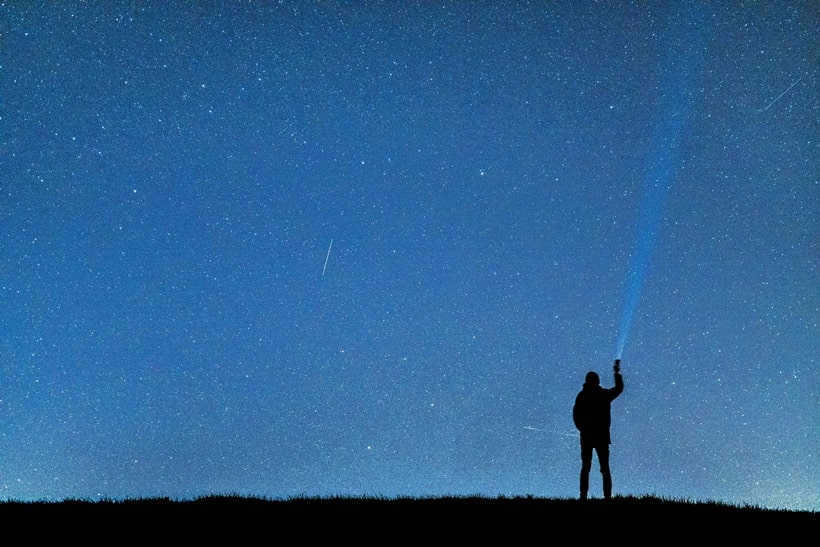
- Natal Astrology
- Relationship Astrology
- Self-development and psychology
- Predictive Astrology
- Horoscopes and Predictions
- Talismans
- Soul Formula
- Numerology
- Astrological Tarot
- World Astrology
- For beginners
- For professionals
- Development of an Astrologer
Enjoy a 7-minute read
Betelgeuse, the second brightest star in the constellation Orion, emits a vibrant red glow that can be easily observed with the naked eye. This celestial body has been known to humanity since ancient times. Determining its exact distance from Earth is challenging, but estimates suggest it is located approximately 495-640 light years away. Recent studies indicate that Betelgeuse is gradually dimming and could potentially explode as a supernova in the not-so-distant future.
In astrology, the star Betelgeuse symbolizes success in military careers and sports. Its positioning in relation to other planets can signify either good fortune and happiness or serve as a warning of bad luck, troubles, and sorrows. Let us explore the various influences this star has on the destinies of individuals.
Betelgeuse: The Fiery Giant Star Illuminating the Night Sky
The enigmatic allure of the celestial sphere has captivated humans for centuries.
The ethereal beauty of distant constellations never fails to mesmerize, as their twinkling radiance ignites the depths of our imagination. On wintry evenings, if you cast your gaze towards the southern horizon, a resplendent figure adorned with a trio of shimmering stars will surely catch your attention. This awe-inspiring constellation is none other than Orion, an exquisite masterpiece visible from Earth between the months of October and April.
However, it is the crimson brilliance of the colossal Betelgeuse that steals the spotlight in the upper left corner. This gargantuan star, with its incandescent glow, serves as a guiding beacon amidst the vast expanse of the night sky.
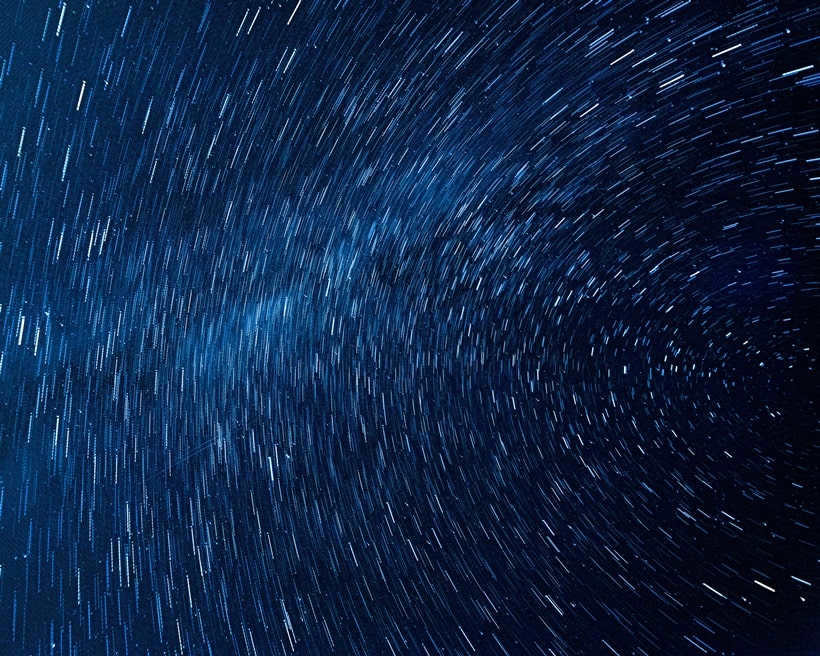
Discovered by astronomers, it is one of the biggest stars in our Galaxy. The luminary’s size changes from 500 to 800 solar diameters due to pulsation. Located more than 400 light-years away, the star shines with a brightness that is 14,000 times greater than that of the Sun. To put it in perspective, Betelgeuse would encompass 300 million stars like our Sun. If this massive star were placed in the center of our solar system, it would reach Mars when it contracts and extend as far as Jupiter when it expands.
Due to its immense size, Earth-based astronomers have had the fortunate opportunity to capture photographs of the surface and dark spots of our planet. A hypothesis suggests that Betelgeuse, as it ages and expands, may have consumed a much smaller neighboring planet, thereby increasing its rotation speed. The absorption of fresh material from its companion could potentially rejuvenate the star, making it difficult to determine its true age.
In recent times, the luminosity of Betelgeuse in the night sky has started to diminish. Astronomers speculate that the star is on a path towards becoming a black hole, triggered by a supernova explosion. Experts believe that the fate of Betelgeuse has already been determined.
No one can predict the precise moment when the planet will meet its end. However, it is certain that after the star’s explosion, it will vanish from humanity’s sight. Some scientists argue that the star’s brightness may eventually be restored, suggesting that it was caused by the ejection of a dust cloud by the planet. Ultimately, the controversy surrounding this colossal celestial body will persist throughout its entire lifespan.
Orion and the star Betelgeuse in the birth chart
In Greek mythology, Orion is a fascinating figure with a life shrouded in enigmas and contradictions. According to certain myths, he is the son of the god Poseidon, while others claim that he was born from the gift of three gods, emerging from the hide of a sacrificial bull. However, all accounts agree on one thing – Orion was an exceptional hunter with the ability to walk on water.
In astrology, the star Betelgeuse can have a profoundly positive impact on the life of individuals born under its influence. These individuals are blessed with great luck and happiness throughout their earthly existence. Furthermore, the positive qualities of the planets present in the same astrological house are amplified. These individuals possess a kind and compassionate nature, their house is filled to the brim with abundance, and they experience success along their life journey.
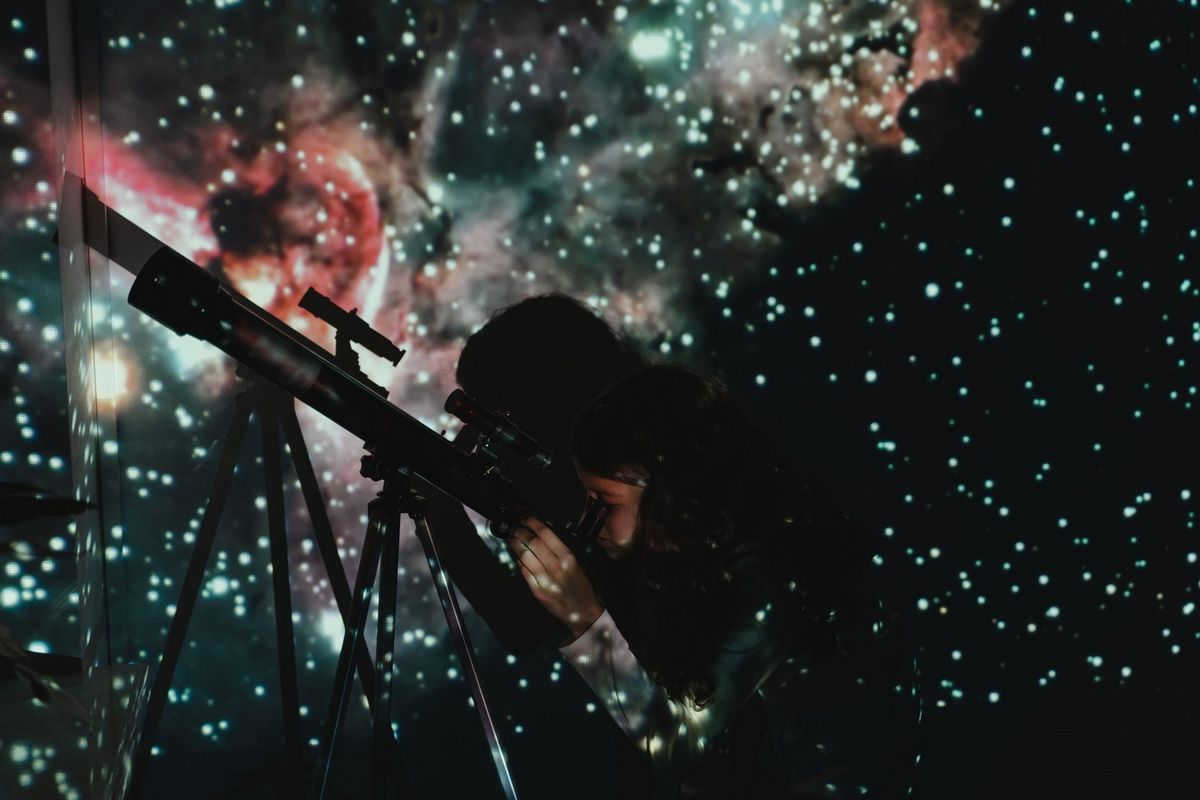

Betelgeuse is a celestial body that amplifies the beneficial impact of adjacent planets. Furthermore, individuals born under its influence are luminous, self-assured, innate trailblazers, exceptionally resilient, and possess captivating personalities.
Betelgeuse stands out among the stars, possessing the ability to bestow effortless worldwide success. Its position on the right shoulder of the celestial Orion is widely recognized and symbolizes good fortune and earthly happiness. Betelgeuse, along with its fellow stars in the constellation, signifies that positive outcomes await individuals in all their endeavors. This celestial body highlights creativity, intuition, and a strong drive to achieve goals.
Depending on its placement in the natal chart, Betelgeuse, a powerful star, can take on different interpretations.
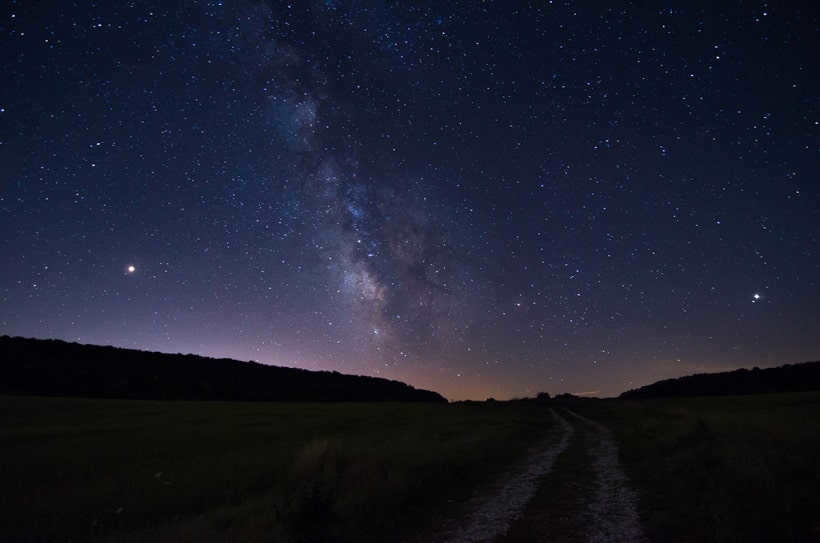
Betelgeuse is currently positioned at its lowest point.
The impact of a star at its nadir becomes apparent over time. An individual’s recognition, success, and fame often come later in life, and sometimes even after death. By examining the cases of Abraham Lincoln and Martin Luther King, it is evident that positive stars in Lincoln’s horoscope played a significant role in his success throughout his life. Additionally, under the influence of Betelgeuse, he achieved a sense of “immortality” following his passing. Similarly, Martin Luther King was born when Betelgeuse was at its nadir, and the Moon’s influence further contributed to his success during his lifetime and his enduring popularity after his physical existence ceased.
The Ascendancy of Betelgeuse
When in the ascendant position, Betelgeuse offers exceptional support to individuals at a young age.
If the energy of this star is further enhanced by neighboring stars, it continues to guide and protect the individual throughout their life. The rising Betelgeuse is known to bring success from early childhood.
One notable example is actor James Dean, who was blessed with the conjunction of Betelgeuse and Jupiter. This celestial combination granted him professional recognition from a young age and he basked in the limelight until his tragic car accident.
Similarly, Marilyn Monroe, under the influence of Mars, achieved success not only as an actress but also as one of the most alluring women of her time. Her fame accompanied her throughout her life, making her an icon of her era.
The Peak of Betelgeuse.
When Betelgeuse reaches its peak, it enhances creativity in early years and brings success in later stages. Charles Dickens, a renowned author of the Victorian era, gained fame and popularity during his middle age, thanks to the influence of Jupiter at the culmination of Betelgeuse. His literary achievements continue to be celebrated even today.

Looking Beyond Betelgeuse.
Betelgeuse’s waning energy reveals its significance as it nears the end of its life.
Throughout his conscious existence, William Blake, a talented artist and poet, endured a miserable life. Fame eluded him until later in life, but his popularity persists even today.
The star plays a crucial role in achieving remarkable positive outcomes in military affairs. It grants individuals with wisdom and intellect. When combined with the Sun, Moon, and Jupiter, it bestows people with extraordinary renown and a joyful existence.
This combination gives rise to exceptional athletes, lawyers, military personnel, and public figures.
Under the influence of the Sun, one can soar to the heavens, but if they plummet from great heights, they risk losing all their accomplishments and merits. There are talents in the realm of the unknown, such as mysticism and witchcraft. In terms of health, there is a likelihood of susceptibility to acute illnesses and feverish conditions. It is essential to undergo regular examinations and maintain a healthy lifestyle.
A sharp intellect and fearless bravery are cultivated. Possessing these traits, one can attain success in life and attain global acclaim. An easily angered temperament increases the chances of getting involved in harmful conflicts. The outward appearance of composure masks a natural inclination towards leadership, resulting in triumphs through well-thought-out strategies.
This combination demonstrates a serious and contemplative approach to life. Individuals born with these characteristics can become renowned for both positive and negative actions. They have the potential to achieve literary recognition or become highly sought-after writers. The journey of life is filled with numerous obstacles and challenges. Succumbing to negative influences leads to self-destruction.
They have an exceptional ability to create unique personal challenges, which makes them intriguing to others. It is important to proceed with caution in order to navigate life’s obstacles successfully. These individuals have a reserved nature and can be difficult to approach. Their eyes reveal a perpetual sense of universal sorrow, though even they may not fully understand the source of it.

This variation offers individuals patience and resilience. As a capable leader, such an individual possesses the ability to uphold their promises and maintain consistency. There is a strong potential to excel as a great commander. However, caution should be exercised as there is a risk of accidents caused by lightning strikes, fires, or explosions.
An intelligent individual with the potential for success in the field of law. The ability to defend one’s stance will contribute to becoming a prominent politician in contemporary society. Additionally, the talent for expressing thoughts through writing will aid in advancement within the literary field.


